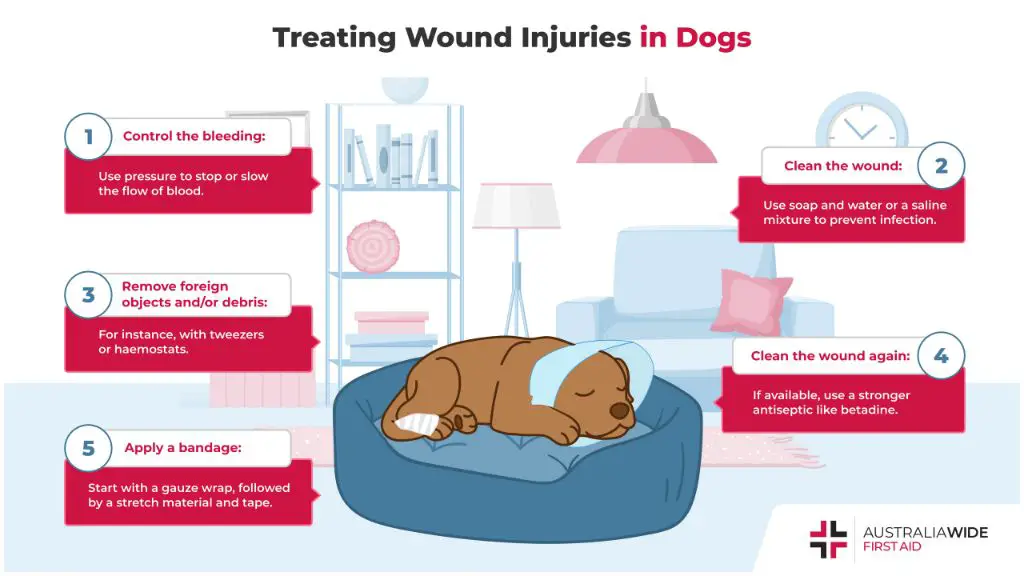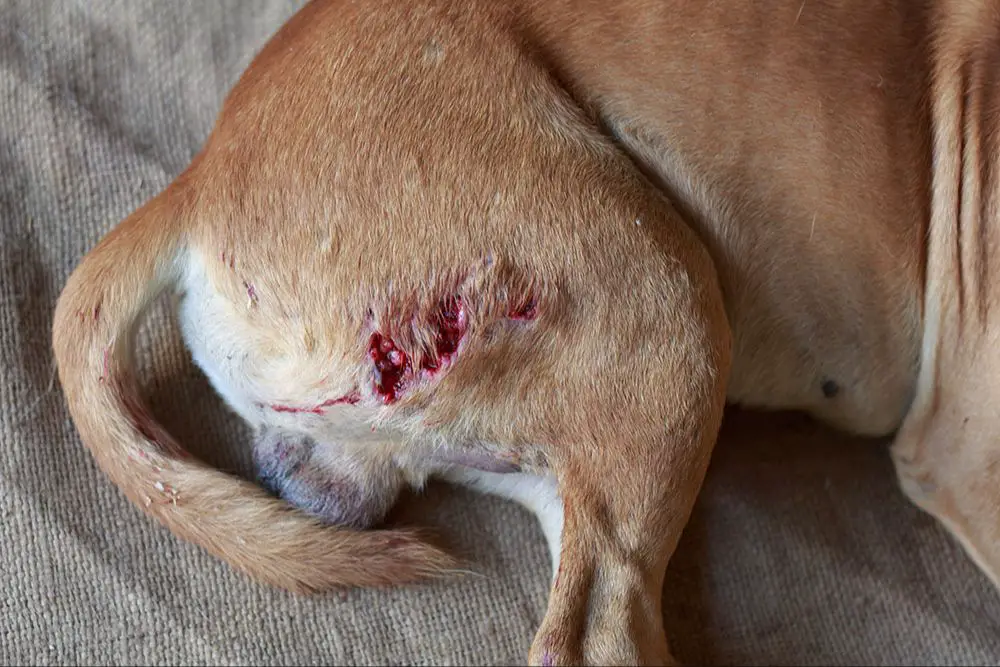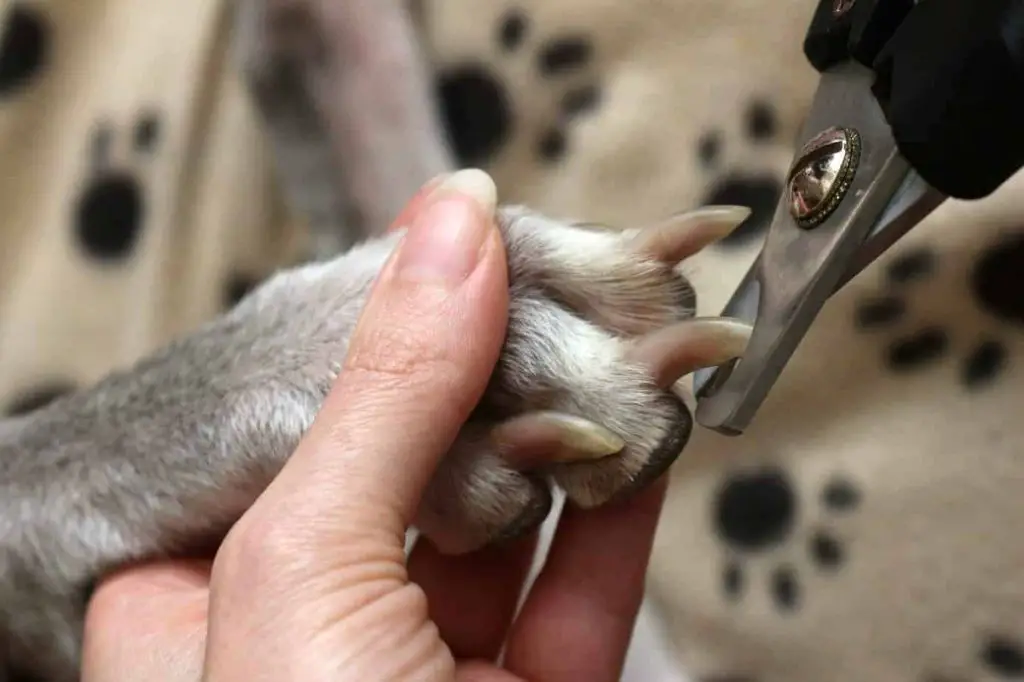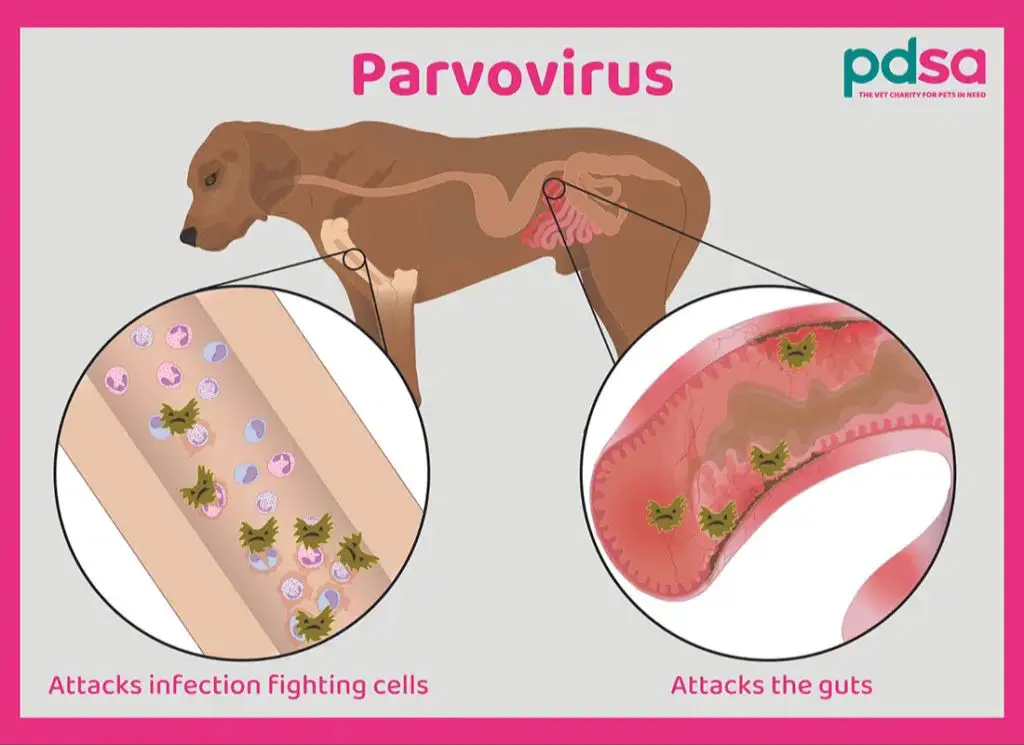Introduction
While dogs often get trivial scratches during play or outdoor activities, some can lead to complications like infection. Scratches can be caused by a variety of things – other animals, sharp objects, or rough surfaces. Often they heal within a few days, but deeper scratches or those showing signs of infection require veterinary attention. If left untreated, infected scratches can spread bacteria through the bloodstream and become very serious.
It’s important for dog owners to monitor all scratches and watch for signs of infection like swelling, redness, pus, or pain. Cleaning the wound properly and applying antibiotic ointment can prevent infection in minor scratches. However, deeper lacerations may need oral antibiotics prescribed by a vet to treat infection from the inside out. Tetanus shots are sometimes administered as well if the scratch is deep or the dog’s vaccine is not up to date.
While most scratches heal without issue, owners should educate themselves on proper wound care, infection risks, and when to seek medical intervention. This overview covers the causes, risks, treatment, and prevention of problematic dog scratches.
Causes of Dog Scratches
Dogs use their claws and teeth during play or when feeling territorial, which can sometimes result in scratches to their human companions. There are four main causes of scratches from dogs:
- Sharp claws – Even when playing gently, a dog’s sharp nails can accidentally scratch bare skin and cause surface-level wounds.
- Rough play – Playful mouthing and energetic play styles, especially in puppies and younger dogs, can lead to scratches from teeth and nails.
- Territorial aggression – Some dogs may react defensively and scratch if they feel their territory or resources are being threatened.
- Prey drive – High prey drive dogs may scratch or nip in an overstimulated state if triggered by a sudden movement or noise.
While most dog scratches are accidental and harmless, they can potentially damage skin and require first aid treatment. Understanding common causes can help owners take precautions against scratches.
Risks of Infection
Dog scratches can easily become infected for several reasons. First, dogs have a lot of bacteria in their mouths from eating and licking. When a dog’s teeth break the skin while scratching or biting, these bacteria can get into the wound and cause an infection. Secondly, dogs often have dirt and debris lodged under their nails, especially if they spend time outdoors. This dirt and grime can also contaminate the scratch and lead to infection. Lastly, the outer layer of skin serves as an important barrier against germs. When this layer is damaged from a scratch or bite, it provides an entry point for bacteria to enter tissue and bloodstream. For these reasons, dog scratches should always be promptly cleaned and monitored for any signs of infection.
Signs of Infection
If the scratch site becomes infected, you may notice some common signs. Look for redness, swelling, pus, or an increase in pain around the wound. As the infection worsens, you may also notice a fever in your dog, indicating that the bacteria has entered the bloodstream.
Redness and warmth spreading from the wound can signify early infection. The swelling may become pronounced and filled with pus. Pus is a thick, cloudy or bloody discharge that indicates the white blood cells are fighting a bacterial invasion.
Increased pain at the scratch site can also signal infection, especially if the pain continues after a few days. Dogs may whimper, lick excessively at the wound, or become reluctant to move the scratched limb.
Fever is a more serious sign the infection is spreading or becoming systemic. Left untreated, the bacteria can enter the bloodstream and multiply. Monitor your dog’s temperature at home if you suspect infection.
If you observe any of these signs of infection in a dog scratch wound, contact your veterinarian right away for an examination and treatment. Infections need medication to improve and prevent dangerous complications.
When to See a Vet
Most minor scratches from dogs can be treated at home with proper cleaning and care. However, you should contact your vet as soon as possible if:
- The scratch or bite punctured deep into the skin.
- There is excessive bleeding from the wound.
- Signs of infection emerge, including redness, swelling, oozing pus, red streaks, increased pain or heat around the wound.
- Your dog scratched near your eyes, mouth, throat, or genital region.
- You have a weakened immune system or chronic illness like diabetes or cancer.
- The scratch occurred from an unknown dog or shows any signs of rabies.
Severe scratches or deep puncture wounds have a higher risk of complication and infection. Contact your vet promptly if you notice any concerning symptoms or if the wound seems deep. Your vet will thoroughly clean and assess the wound, determine if stitches are needed, and prescribe oral or topical antibiotics as necessary.
Signs of infection require swift medical care as well. Infected wounds can progress to cellulitis, tissue damage, abscesses, and other serious issues if left untreated. Redness, swelling, oozing pus, red streaks, increased pain or heat signal infection, which needs veterinary attention and antibiotic treatment.
Any dog scratches on delicate body parts like the eyes, mouth, throat or genitals also warrant urgent vet care to prevent severe infections or injuries. Seek prompt attention for wounds in these sensitive areas.
Cleaning the Wound

If your dog has been scratched, it’s important to clean the wound right away to help prevent infection. Here are some tips for properly cleaning a dog scratch:
First, use clean tweezers or gloves to gently remove any debris, such as dirt, from the wound. Be careful not to cause further damage or pain. Once debris is removed, rinse the wound with clean water. This will help flush out any remaining particles. Tap water is fine for an initial rinse. However, a sterile saline solution is best for thoroughly cleaning the wound and will cause less irritation.
After rinsing, dry the area around the wound and apply a small amount of antibiotic ointment, such as Neosporin. The ointment will help prevent infection and keep the wound moist as it heals. Be sure not to apply ointment over any bandage, as this can lead to infection. It’s a good idea to use an ointment containing pain reliever as well, to help soothe pain and inflammation. Keep the wound covered with a light bandage or gauze to protect it. Change the bandage regularly.
Antibiotics

If a dog scratch becomes infected, a veterinarian may prescribe oral or topical antibiotics. Oral antibiotics like amoxicillin or cephalexin can treat infections that have spread deeper into the tissue. Topical antibiotics like mupirocin ointment can treat more superficial infections.
The typical antibiotic course is 7-10 days to fully treat a dog scratch infection. It’s important to give all doses as prescribed, even if the infection seems to be improving. Stopping antibiotics early can lead to recurring or resistant infections. The veterinarian will advise on the specific dose and duration based on factors like the dog’s weight, health status, and severity of infection.
Tetanus Shot
If your dog has not received a tetanus vaccine recently or is overdue for a booster shot, your vet may recommend a tetanus injection after a dog scratch. Tetanus is caused by bacteria that can enter the body through wounds and release a toxin. Some symptoms of tetanus include muscle spasms, stiffness, trouble swallowing, and seizures. Tetanus can be fatal in dogs if left untreated.
Veterinarians typically recommend an initial vaccination series for tetanus for puppies, followed by booster shots every 1-3 years depending on risk and lifestyle factors. If your adult dog has not had a tetanus booster in the last 3 years or you are unsure of their vaccination status, your vet may administer a tetanus shot after a significant wound like a dog bite or scratch. This helps prevent the risk of a rare but extremely serious tetanus infection.
Prevention Tips

There are several ways pet owners can help prevent dog scratches from happening:
Trim nails regularly – Keeping your dog’s nails neatly trimmed will minimize scratches if they jump up or paw at you. Use clippers designed for dogs and trim just the clear portion of the nail.
Provide scratching posts – Giving your dog appropriate surfaces to scratch, like scratching posts, can help divert scratching behavior away from people. Place posts around your home and reward your dog for using them.
Train your dog – With positive reinforcement training, teach your dog not to jump on people and to keep all four paws on the floor when greeting. This will reduce scratches from jumping.
Supervise play – Watch your dog closely when playing with people or other pets. At the first sign of scratching or overly rambunctious play, interrupt and redirect their energy to a toy.
When to Return
If a dog’s wound becomes infected after receiving initial treatment, it’s important to follow-up with the veterinarian. Signs of a persisting infection include:
- Continued redness, swelling, pain around the wound
- Pus or foul-smelling discharge from the wound
- Loss of appetite, lethargy in your dog
- Fever
Infected wounds will likely need further cleaning, oral antibiotics, or antibiotic ointments. Leaving an infection untreated can allow it to spread, leading to complications like cellulitis or blood poisoning. Stay in close contact with your vet and follow their recommendations for care. You may need to restrict activity, use an Elizabethan collar to prevent licking, and follow up frequently until the infection is fully resolved.

With prompt veterinary attention and proper at-home care, most infected dog scratches can heal without issue. But it’s important not to wait if signs of infection persist or worsen. Catching it quickly improves outcomes and prevents suffering in your dog.